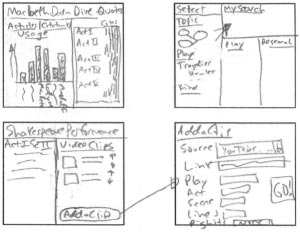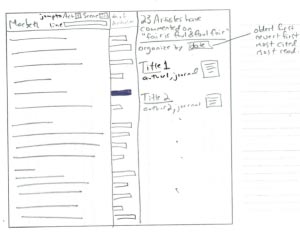Understanding Shakespeare

This is the second in a short series of posts on Understanding Shakespeare. In the first post, we described the partnership with the Folger Shakespeare Library that made the project possible.
We had a partner to work with in the Folger Shakespeare Library. And we had the idea: give scholars and students better links between the plays and the scholarship. The question was: how should we go about exploring and developing this idea? For our answer, we took our inspiration from the Nordstrom Innovation Lab, who test out new ideas using a “flash build” – you can see a video of one of their builds here.
You might have heard of a flash mob, where a group of people converge on a place at the same time, puts on some performance (pillow fight!), and then disbands as quickly as they formed. A flash build is similar, but with, sadly, less dancing and fewer pillows. The team meets in a single location, focuses on a single effort, and, informed by regular access to end users, comes away with a piece of working software.
With this inspiration, we decided to organize ourselves around a flash build, in which the Labs team would hold onsite at the Folger the week of September 29th. To make that work, we had some preparation to get through.
We started with a series of interviews of Shakespeare scholars and students, whom we contacted with the help of the Folger. These interviews were exploratory by nature. They gave us a picture of who we were trying to help and how they currently moved between the play and scholarship about the play.
Informed by these interviews and the possibilities they suggested, we embarked on the work to create the links between the play and the scholarship. We’ll describe that work in more detail in a future post, but in the meantime suffice to say that Ron Snyder, the Labs team’s lead technologist and Yuhang Wang, JSTOR’s Data Scientist, worked some magic to get a deep level of granularity that made this site possible. We then connected that data into a relatively simple front end, on which we could iterate quickly during the flash build.
Our preparatory work complete, the Labs team arrived at the Folger on September 29th ready for the flash build. We started the week with a “design jam” with Folger staff. A design jam is an organized brainstorming technique in which participants seek to generate many possible approaches to a particular design problem; in this case, we were looking for ways we might link the play to the secondary literature. You can see an example of the sort of material created in this picture.

One of the many pages of ideas from our Design Jam.
With these ideas in our pocket, we created a set of paper prototypes like the one shown here – pencil drawings that explored in greater detail a variety of different approaches. In-person interviews with Shakespeare scholars and students allowed us to test the different approaches before settling on one, which we honed using low-fidelity prototypes or wireframes.

Hand-drawn paper prototype. Pretty messy, it did the job
By Wednesday, we had a good idea of what would be both valuable to users and feasible technically. By Thursday, we had a working site and informed by another interview or four, we’d polished that to the point where it did a pretty good job of demonstrating the possibility of this approach. On Friday, we demonstrated the working site to the employees and fellows at the Folger.
In the few weeks following the flash build, we did do some polishing of the site, and we added five more plays to the site to increase the likelihood that people might find it useful. You can see what we came up with at Understanding Shakespeare. We’re interested in hearing what you think of it. We also would love to hear your stories of how you’ve used the site. Toss a comment in below, or send us an email at labs@ithaka.org.
